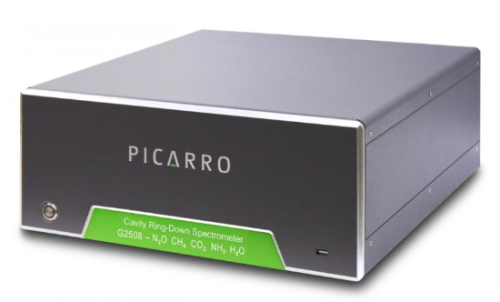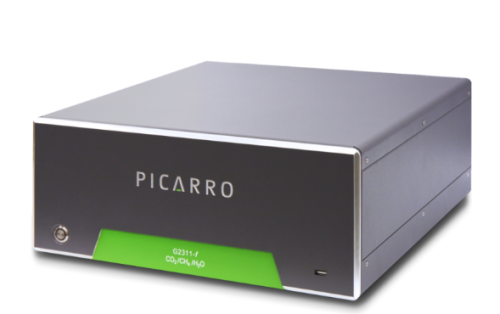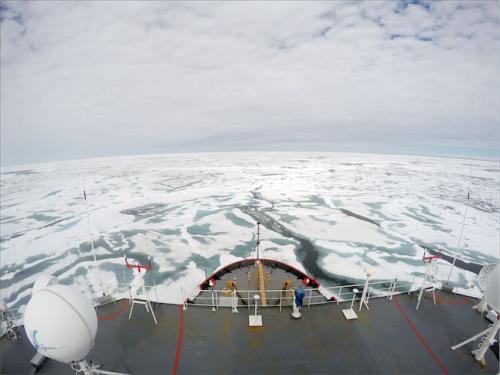PI5310 气体浓度分析仪
产品PI5310 气体浓度分析仪专门设计用于高精度测量大气中的氧化亚氮(N2O)和一氧化碳(CO) 。中红外(mid-IR)光腔衰荡光谱(CRDS)技术以低于 5秒的间隔在 1 至 1500 ppb 的测量范围内达到万亿分之一(ppt)的精度。PI5310 是世界气象组织(WMO)和综合碳观测系统(ICOS)等要求最严格的温室气体监测网络进行长期大气监测的理想之选。SI2205 气体浓度分析仪
产品Picarro SI2205 气体浓度分析仪提供快速、精确、实时的氟化氢(HF)测量,灵敏度为万亿分之一(ppt),漂移可忽略不计,适用于大气科学和空气质量应用。它在关键的气体通路采用了涂层部件。减少了HF 分子粘附在通道表面的倾向,从而改善了测量响应时间。SI2205 几乎不需要消耗品,因此具有显著的易用性和较低的拥有成本优势。该分析仪坚固耐用,易于运输。SI2108 气体浓度分析仪
产品Picarro SI2108 气体浓度分析仪以万亿分之一(ppt)的灵敏度对氯化氢(HCl)进行精确的实时监测,适用于大气科学、室内和室外空气质量以及危险评估应用。它在关键的气体通路中采用了涂层部件,减少了氯化氢分子粘附在通道表面的倾向,从而改善了测量响应时间。 它几乎不需要任何消耗品,具有显著的易用性和较低的拥有成本优势。分析仪坚固耐用,易于运输。SI2104 气体浓度分析仪
产品Picarro SI2104 气体浓度分析仪以万亿分之一(ppt)的检测下限(LOD)对硫化氢(H2S)进行精确、实时的监测。SI2104 分析仪是一款实现技术突破性的、可现场部署的分析仪,支持多种应用。它可用于监测环境空气质量、烟囱排放和绘制硫化氢排放羽流图。G2509 气体浓度分析仪
产品Picarro G2509 气体浓度分析仪设计用于畜牧业、粪便处理和肥料研究领域。在这些充满挑战性的环境中,高浓度的环境甲烷和氨气动态变化快,导致难以精确测量氨气和温室气体。G2207-i 同位素与气体浓度分析仪
产品Picarro G2207-i 气体浓度与同位素分析仪将高精度和低漂移 O2 浓度测量与环境空气中的 δ18O 分析相结合,使其成为用于包括大气中氧监控等具有挑战性应用的理想选择,能够确定碳循环中所涉及的生物地球化学过程。
Caddy™ 连续流接口
产品Caddy TM 连续流接口(A2100)将市售的固态和液态整体样品制备仪器(包括 Picarro 燃烧模块)连接到 Picarro 分析仪,以进行高精度碳同位素(13C)测量。L2130-i 同位素与气体浓度分析仪
产品Picarro L2130-i 同位素分析仪可实现水稳定同位素的高质量测量,适用于古气候学、水文学和海洋学等严苛应用。运用各种 Picarro 外围设备,可以对取自液体、气体和固体的水样品进行 δ18O 和 δD 高精度测量。
G2210-i 同位素分析仪
产品Picarro G2210-i 同位素分析仪专为满足科学界实施实时甲烷排放源归属的需求而设计。高精度测量大气中甲烷和乙烷的功能与二氧化碳和水汽测量相结合,为用户提供一种用来测量并确定垃圾填埋场、压裂站和废弃油气井等甲烷排放源的独特工具。
G2308 气体浓度分析仪
产品Picarro G2308 气体浓度分析仪可同步精确测量氧化亚氮(N2O)、灵敏度为十亿分率(ppb)的甲烷(CH4)和灵敏度为百万分率(ppm)的水汽(H2O),针对大气科学、空气质量和量化排放应用所产生的漂移可忽略不计。
G2508 气体浓度分析仪
产品Picarro G2508 气体浓度分析仪可同步测量氧化亚氮(N2O)、甲烷(CH4)、二氧化碳(CO2)、氨(NH3)和水汽 (H2O),灵敏度为十亿分率(ppb),针对农业与土壤科学、生态学和量化排放应用所产生的漂移可忽略不计。
G2401 气体浓度分析仪
产品Picarro G2401 气体浓度分析仪可同步精确测量一氧化碳(CO)、二氧化碳(CO2)、灵敏度为十亿分率 (ppb)的甲烷(CH4)和灵敏度为百万分率 (ppm) 的水汽(H2O),针对大气科学、空气质量和量化排放应用所产生的漂移可忽略不计。
G2203 气体浓度分析仪
产品Picarro G2203 气体浓度分析仪可同步精确测量甲烷(CH4)和乙炔(C2H2),灵敏度为十亿分率(ppb),通过使用 C2H2 示踪剂来测量可量化的排放率,测量垃圾填埋场或其它甲烷源中的逸散性 CH4 排放时的漂移可忽略不计。
G2311-f EC 通量气体浓度分析仪
产品Picarro G2311-f 通量气体浓度分析仪可在 10 Hz 下针对涡度相关方法、梯度方法和涡旋累积法,同步精确测量二氧化碳 (CO2)、甲烷 (CH4) 和水汽 (H2O) 。
G2401-m 航空专用气体浓度分析仪
产品Picarro G2401-m 气体浓度分析仪可同步精确测量一氧化碳 (CO)、二氧化碳 (CO2)、灵敏度为十亿分率 (ppb) 的甲烷 (CH4) 和灵敏度为百万分率 (ppm) 的水汽 (H2O) ,针对大气科学、空气质量和量化排放应用所产生的漂移可忽略不计。
G2301 气体浓度分析仪
产品Picarro G2301 气体浓度分析仪可同步精确测量二氧化碳(CO2)、灵敏度为十亿分率(ppb)的甲烷(CH4)和灵敏度为百万分率(ppm)的水汽(H2O),针对大气科学、空气质量和量化排放应用所产生的漂移可忽略不计。
G2204 气体浓度分析仪
产品Picarro G2204 气体浓度分析仪可同步精确测量甲烷(CH4)和硫化氢(H2S),灵敏度为十亿分率(ppb),针对垃圾填埋场、炼油厂、造纸厂或工业厂房的排放测量所产生的漂移可忽略不计。
G2106 气体浓度分析仪
产品Picarro G2106 气体浓度分析仪可精确实时测量乙烯(C2H4) 和水汽(H2O),灵敏度为十亿分率(ppb),针对农业与土壤科学应用所产生的漂移可忽略不计。
PI2114 气体浓度分析仪
产品Picarro PI2114 气体浓度分析仪可测量低至 3 ppb 的过氧化氢(H2O2),以避免药物发生氧化并确保药物稳定性。主要的制药、合同加工外包(CMO)及隔离器公司都采用 Picarro 过氧化氢分析仪,来实现强效原料药(API) 和生物制药生产以及无菌灌装与加工。PI2114 分析仪运行快速且使用简便,无需使用化学品或耗材。同时,只需实施少量校准与维护,即可最大限度地降低运行成本。G2205 气体浓度分析仪
产品Picarro G2205 气体浓度分析仪可精确实时测量氟化氢(HF)和水汽(H2O),灵敏度为万亿分率(ppt),针对大气科学和空气质量应用所产生的漂移可忽略不计。
G2103 气体浓度分析仪
产品Picarro G2103 气体浓度分析仪可精确实时测量氨 (NH3) 和水汽 (H2O) 。这款分析仪在关键的气体通路中安装了涂层部件,减弱了 NH3 分子粘附到气体通路表面上的倾向,继而改善测量响应时间。
G5131-i 同位素与气体浓度分析仪
产品Picarro G5131-i 同位素与气体浓度分析仪可同步测量 N2O 中的位点特异性及批量 δ15N 和 δ18O。它是一项理想的解决方案,适用于在现场实时地或在实验室中通过收集样品来识别和测量 N2O 排放源。
G2131-i 同位素与气体浓度分析仪
产品Picarro G2131-i 同位素与气体浓度分析仪能够在各种应用下进行灵活的测量,从大气和海洋科学研究到食品与饮料的来源与真实性无不涵盖其中。这款分析仪能够测量二氧化碳中的 δ13C,精度小于 0.1 ‰。这款分析仪能够以十亿分之二百(200 ppb)和十亿分之五十 (50 ppb) 的精度同步分别测量二氧化碳(CO2)和甲烷(CH4)的气体浓度。以百万分率(ppm)的精度来测量水汽(H2O),从而以干气摩尔分数来校正和报告 CO2 和 CH4。
PI5310 – 大气 N2O 和 CO 监测的解决方案
文章在全球致力于理解和应对气候变化的过程中,全球各地的网络正在监测温室气体 (GHGs)。Picarro 分析仪凭借其独特的高精度 CRDS 技术,被广泛应用于包括所 有欧洲综合碳监测系统(ICOS)大气主题中心(ATC)网络在内的许多监测网络中。 随着 PI5310 氧化亚氮(N2O)和一氧化碳(CO)分析仪的推出,Picarro 提供了符 合并超越世界气象组织(WMO)兼容性目标和 ICOS 规格要求的 N2O 和 CO 大气监测 的最佳解决方案。2021 年夏季野火期,俄勒冈州西北部地区的甲醛测量
文章Jonathan Bent, Ph.D., Senior Application Scientist, Environmental
Measurement Location:
ORDEQ Near-road Site
Tualatin, OR
45.3992°, -122.7458°国际温室气体监测网络在实现“双碳”目标中的作用
文章大气中二氧化碳等温室气体的浓度逐年增加,导致全球变暖,给人类的生产和生活带来了造成了很大的影响。率先采取行动的国家向国际社会郑重承诺减少温室气体(GHG)的排放,并在特定日期前实现“碳达峰”和“碳中和”目标。在中国西湖大学移动部署同位素碳分析仪以补充卫星温室气体数据模型
文章在 Picarro,我们喜欢客户分享他们对我们的分析仪在现场的创新集成和应用。这个客户成功故事的主角是中国西湖大学的助理教授张羽中博士。在我们的中国合作伙伴北京世纪朝阳科技发展有限公司的帮助下,张博士最近在他的汽车上安装了 G2201-i,以获得车载温室气体测量结果。我们非常感谢张博士和 世纪朝阳公司 的努力,为我们带来了这个精彩的故事。请欣赏!
助理教授张羽中博士在佐治亚理工学院获得博士学位后,前往哈佛大学攻读博士后。他于2019年加入新成立的西湖大学,从事大气分析模型的建立工作。西湖大学正在探索国家高等教育改革的方向。它是一所以前沿领域和新型办学模式为主,力求小而精、高起点、研究型的新型非营利性高等学校。加入西湖大学后,张羽中博士决定利用稳定碳同位素测量技术,专注于温室气体观测和排放溯源工作。
揭示南极洲过去气候变化的欧洲青年研究人员新网络
文章Picarro is proud to support important climate science. We are a partner of the DEEPICE project, an innovative training network in instrumentation, ice core analysis, and glaciological and climatic modelling. For their new European collaboration, we’re excited to support training schools and host an intern to assist in the development of analytical methods for ice core measurements that will answer key questions about the impact of large climate shifts on the Antarctic ice sheet.代理气体验证:一种更安全,更容易的方法来验证有害,腐蚀性和反 应性微量气体的测量
文章一系列环境研究问题和许多工业应用,如大气中的温室气体监测,都需要高精度的测量痕量气体。光腔衰荡光谱技术 (CRDS) 是实现最高精度测量二氧化碳、甲烷、氧化亚氮和一氧化碳等痕量气体浓度的领先技术。然而,危险性、腐蚀性和反应性气体又带来了额外的挑战。通过模拟未来环境条件调查气候变化对生态系统的影响
文章众所周知,由于化石燃料的燃烧,大气中的二氧化碳浓度正在持续上升,二氧化碳等温室气体排放量的增加正在导致气候变化,并引发生态系统的巨大变化。二氧化碳浓度的升高对于生态系统的最重要的影响是使植物的光合作用增强,生长加快。增强的光合作用提升碳固定是一个重要的额外全球二氧化碳汇,可减缓大气二氧化碳浓度的增加。 为了研究植物生长在未来会受到怎样的影响,生态学家和植物生物学家在世界各地的不同生态系统中布设了二氧化碳富集(FACE)设施,以模拟大气二氧化碳浓度的升高。FACE设施由一套排放高浓度二氧化碳气体的管道组成,这些管道围绕试验田呈圆形排列。对试验田的二氧化碳浓度进行监测并保持在所需的水平。确保治疗性生物制品生产质量的三种方法
文章The most effective and valuable new therapeutic products today are biologics, including peptides, proteins, and antibody-drug conjugates (ADCs), as well as cells, cell-derived products, and gene therapies. Many of these products are susceptible to oxidative damage by trace levels of hydrogen peroxide.利用稳定碳同位素追踪和量化蜂鸟晚间进食的代谢途径
文章任何看过蜂鸟从花朵或喂食器中啜食的人都能体会到这些小鸟是多么美丽、活跃和饥饿。它们似乎总是在不停地移动,努力地寻找和保卫含糖花蜜的花朵,这些花蜜是它们白天活动的能量。但当太阳落山时,蜂鸟就会回到它们夜间的栖息地,暂停觅食,进行长夜休息。从北极和南极洲海岸之间的海面观测数据中识别海洋蒸发的信号
文章The following study takes us through the voyage of the Polarstern ice breaker of the Alfred Wegener Institute in Germany.仅 30 ppb 的气化过氧化氢 (VHP) 能够氧化和破坏药物
文章由于生物制剂业已取代小分子药物而成为众多领先制药公司的主要关注点,因此稳健的隔离器及限制进出隔离系统 (RABS) 制造工艺仍然是一个不断演变的过程。在这种环境下,随着实施更佳 VHP 监测的需求快速增长,Picarro H2O2 分析仪也越来越受到人们的青睐。监测南极地区水蒸汽、降水和积雪表面的同位素组成(δ18O、δD)
文章在 Picarro 公司,我们乐于听到研究小组如何将我们的系统运用到他们的项目中。来自圣彼德堡北极与南极研究所 (AARI) 的安娜·科萨切克 (Anna Kozachek) 花时间撰写了一篇短文,其中讲述了她的团队如何在南极环航探险 (ACE) 项目中使用 Picarro L2130-i 和 L2120-i 的详情。加拿大不连续多年冻土中泥炭厌氧分解的实验性激发效应研究
文章在皮卡罗 (Picarro) 公司,我们乐于听到研究小组如何将我们的系统运用到他们的项目中。克里斯蒂安·埃斯托普-阿拉贡内斯 (Cristian Estop-Aragonés)、利亚姆•霍夫曼 (Liam Heffernan) 和大卫·奥莱费尔特 (David Olefeldt) 与加拿大阿尔伯塔大学可再生资源系花时间撰写了一篇短文,其中讲述了他们如何在最近的热喀斯特沼泽研究中使用 Picarro G2201-i 分析仪和小样本引入模块 (SSIM)。感谢这三位人士与我们分享经验。使用小样品进样模块(SSIM2)测量少量气体样品的浓度
文章The Picarro Small Sample Introduction Module (SSIM) is designed for processing small volumes of gas samples through a Picarro analyzer. Through a minor modification, we can now expand the functionality of the SSIM so that more accurate concentration measurements can be performed on both isotopic and concentration analyzers.
高盐水的稳定同位素分析
文章该系列文章由三部分组成,本文为第二篇,探讨了 Picarro 分析仪、系统和配件如何确保对具有挑战性的海水和高盐水样品实现准确测量。第一篇文章海水的水稳定同位素测量介绍了实验室间的研究结果,该研究旨在评估与同位素比质谱 (IRMS) 测量结果的一致性和值相比,通过光腔衰荡光谱 (CRDS) 所得测量结果的质量。本篇文章报道了对 CRDS 用于高盐水分析的评估。测量北美偏远地区温带山地生态系统中的土壤碳通量
文章在Picarro公司,我们经常会撰写关于我们产品和应用的文章,但更愿意阅读客户是如何在他们的研究项目中运用我们的产品和应用的内容。科尔·布拉赫曼 (Cole Brachmann)、吉耶尔莫 赫尔南德斯·拉米雷斯 (Guillermo Hernandez Ramirez) 和大卫·希克 (David Hik) 与埃德蒙顿阿尔伯塔大学生物科学系和可再生资源系花时间撰写了一篇关于他们所实施的夏季土壤通量研究的短文。感谢这三位人士与我们分享经验。美国海岸警卫队希利(Healy)号破冰船实施北极水循环和碳同位素循环研究:阿拉斯加楚科奇海,2016 年 7 月
文章北极地区的水文循环和碳循环目前正随着气候变迁而不断变化,包括海冰覆盖范围及其厚度、北冰洋酸碱度(pH 值)以及初级生产力格局和食物网动力学模式方面发生的变化。此外,与海冰有关的蒸发过程变化正在影响着冬夏两季的降水特征以及更广泛的气候模式。举例来说,北极涡旋转移使更多北极气团抵达低纬度地区,这可能会导致美国东北部出现更频繁的极端天气事件。亚马逊河上的“海市蜃楼”
文章这个故事始于20多年前,当时Jeffrey Richey教授的研究小组开始考虑热带地区,特别是亚马逊河盆地,对全球碳循环的重要性。考虑到全球碳循环的“未知碳汇”,他们想要考察亚马逊是从大气中吸收碳,还是向大气中释放碳,又或者保持碳平衡。Welker 实验室采用光伏电池(PV)供电
文章对于任何科学设备的远程部署而言,供电问题都是一个挑战,但阿拉斯加安克雷奇大学的Jeff Welker小组克服了这个挑战。作为NSF极地项目分部的北极观测网EAGER基金(“高风险高收益”)的一部分,Jeff Welker研究小组将一台Picarro L2130-i部署到了Toolik野外观测站,该观测站位于阿拉斯加北部的偏远地区(北纬 68°38′,西经149°36′),距离北冰洋以南约185 千米的Brooks山脉的北麓,海拔约760 米(图 1)。利用稳定水同位素提高农业用水效率
文章笔者刚刚结束了为期一周的迪拜之旅,在那里参加并主持了国际原子能机构的区域培训课程,内容是“使用同位素和其它常规技术将蒸发蒸腾(ET)分解为蒸发(E)和蒸腾(T)”。为期五天的技术课程吸引了来自整个中东地区的约 15 位科学家,围绕理解农业用水效率的重要性展开各种形式探讨,尤其是如何使用稳定同位素技术将农作物的水分损失划分为“良性”的水分损失(蒸腾)和“不良”的水分损失(蒸发)。您可以想象这在缺水现象非常普遍、大部分农业灌溉都使用劣质水(例如咸水和废水)的中东干旱沙漠地区是多么重要。Valerie Morris, Bruce Vaughn 和INSTAAR 稳定同位素实验室团队
文章“欢呼:我们成功了!” 现在是北极与高山研究所 (INSTAAR) 稳定同位素实验室 (SIL) 庆祝欢呼的时刻:Valerie Morris,Bruce Vaughn和 SIL 团队终于完成了南极西部冰原分区(WAIS)冰芯的的所有测量工作!SIL 团队使用定制的连续流动融化系统搭配 Picarro L2130-i,完成了南极西部冰原分区 06 A 冰芯的稳定同位素分析工作。这是来自极地冰芯的第一个自上而下的连续超高分辨率同位素记录!智利水汽同位素测量日志:在地球表面最干燥的地方之一进行的测量(第2部分)
文章In the second part of the blog post of his Chilean research diary, Prof. Joe Galewsky will focus on the details and significance of his research in Chile, an account that is captivating by all means.
Serena Moseman-Valtierra与沿海湿地的蓝碳封存
文章Serena Moseman-Valtierra 博士是金斯顿罗德岛大学的助理教授和盐沼生态学家。她的课题结合了生态实地实验、生物地球化学技术和分子工具来研究沿海湿地的氮循环。里约热内卢天主教大学
文章BRAZIL — The Brazilian bottled mineral water market is valued at a sizeable multi-billion liters produced annually. This large bottled water production associated with a surge in its seasonal demand presents a tempting opportunity for counterfeits to make their way into the Brazilian marketplace.水文学家 Ricardo Sánchez-Murillo 建立了哥斯达黎加第一个稳定同位素实验室
文章哥斯达黎加国立大学的 Ricardo Sánchez-Murillo 预测,即使是在中美洲等全球最潮湿的地区也会面临水资源挑战。利用他在爱达荷大学莫斯科校区研习期间获得的经验,他打算通过研究哥斯达黎加鲜为人知的供水系统来寻找解决方案。.
Stanislaw Halas 博士与位于波兰卢布林居里夫人大学稳定同位素实验室
文章Stanislaw Halas 教授的稳定同位素实验室位于波兰卢布林的居里夫人大学(UMCS-Lublin)物理大楼的一楼。






















































